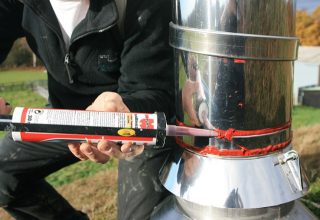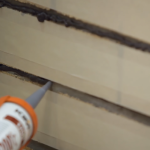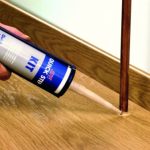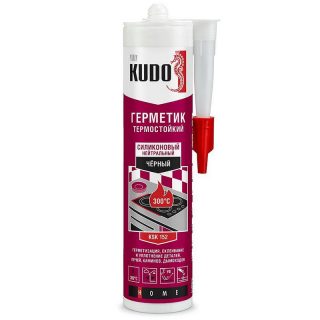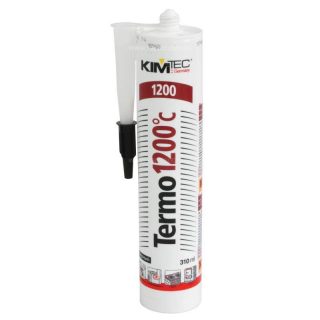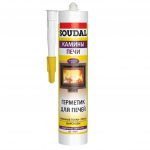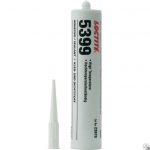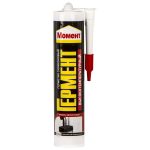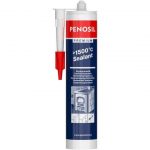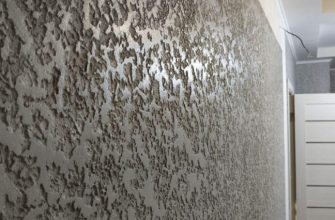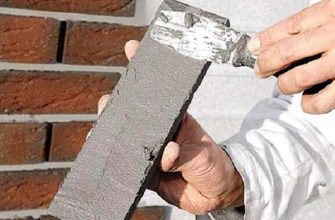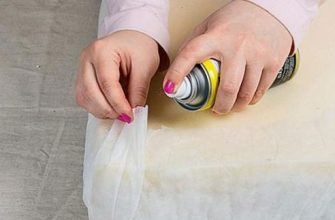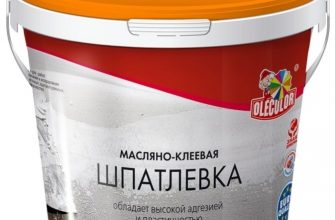Materials with increased resistance to high temperatures are used in construction and repair. In the process of erecting structures, a heat-resistant sealant is used for the chimney, heating system, fireplace masonry. High-temperature seals are used to seal the cracks in rooms with a high degree of fire hazard. Compounds seal seams, protect against aggressive environment, corrosion, and other negative factors.
Description of heat resistant sealants

Polymeric materials have a pasty viscous consistency, they are packaged in tubes with a movable bottom, tubes, soft packages like sausages and buckets with lids.
When ready for work, the trains are:
- One-component. The materials can be used immediately, they do not need to be diluted, mixed. The tubes are tucked into a pistol and squeezed into the prepared seam.
- Two-component. Sealant and hardener are purchased in different containers, and mixed before work. Such compositions are more often used in professional construction, in private houses - rarely.
Silicone sealants are divided into acidic and neutral... The first variety contains acetic acid in the composition; when applied, a pungent odor is emitted. Due to their high acidity, they are not used on metals, polystyrene, since the substance corrodes the surface. Neutral sealants release water and alcohols during application, so there are no restrictions on application.
Silicone and silicate-based high-temperature oven sealants are replacing asbestos-based compounds in construction.
Main characteristics

Solidification (polymerization) takes different time depending on conditions. The process is influenced by air humidity and temperature. Sealants with increased resistance to high temperatures are applied strictly according to the instructions in order to maintain the protective performance.
Optimum hardening conditions:
- apply a sealant at + 5 ° - + 40 ° C, ideally, if the indicator is at + 20 ° С, and the humidity is 50%;
- after solidification, the composition does not change qualities in the temperature range -65 ° - + 315 ° С, heat-resistant ones withstand up to + 1200 ° С;
- when the temperature falls below + 5 ° С (up to 0 ° С) the material is also laid in the seam, while getting rid of ice, snow, condensation drops.
The heat-resistant sealant cures from the surface and then hardens on the inside. When working, do not violate the recommended layer thickness so that the sealant is completely frozen.
Solidification stages:
- The first 30 minutes. A film is formed on the surface, the mass hardens, ceases to stick to the hands. The composition is soft under the top layer.
- After half an hour. The whole mass gradually dries, the material feels harder to the touch. Acid varieties polymerize completely in 6 - 8 hours, neutral ones take about a day.
Slots of great depth and width are closed several times, waiting for the complete hardening of the previously applied mass. After hardening, the seal does not emit toxic substances into the air, even when the temperature rises. The result is a flexible strip that stretches and contracts together with the material of the structure.
Scope of application
When erecting fireplaces, the seams are treated with a heat-resistant sealant. Fireplace and stove sealant withstands high temperatures, open fire.
Refractory compounds are used in the following cases:
- sealing joints exposed to high temperature action;
- sealing joints between metal parts;
- sealing gaps in the production of electric motors and pumps;
- when laying stoves, arranging smoke ducts in walls, installing hinged chimneys.
Refractory pastes are used when installing underfloor heating in a house or apartment. The heat resistance of the sealant will help to seal the seams when installing ventilation pipes, air conditioning systems. Such compositions are used in the case of installing built-in equipment.
The most commonly used refractory oven sealant is in the construction of heating facilities, installation of boilers, gas units... The operation of such equipment involves the release of a large amount of heat, various emergencies.

Varieties of compositions
Refractory compositions are made on the basis of silicone and silicate, depending on the raw material, their ability to withstand critical temperatures varies.
Produce types:
- Heat-resistant refractory based on sodium silicate. They transfer temperatures up to + 1200 ° С, a one-time exposure up to + 1600 ° С is allowed.
- Heat resistant based on silicones. The maximum allowable temperature is + 350 ° С.
The first type of gray or black is found in tubes with tips or in the form of soft metallized packaging. The container has a mark about the fire resistance of the material. Such compositions are used inside stoves, fireplaces. After hardening, heat-resistant materials acquire high strength, but elasticity suffers. They are not used in places with strong vibrations.
Silicate refractory pastes do not adhere well to smooth surfaces. Non-flammable compounds work without destruction under extreme conditions when exposed to open fire. In the event of a fire, such sealants expand and form a dense coke layer. It turns out an obstacle in the path of fire and smoke, which cannot penetrate into neighboring rooms through blocked cracks.
Heat-resistant silicone seals are used in the exterior decoration of heating structures. They seal blind slots when installing external pipelines of the heating system, they are used to fill butt joints. After hardening, an elastic seam is obtained.
For workshops in which work that is hazardous in terms of fire (welding, chemical processes, laboratory research) are carried out, silicone heat-resistant or silicate heat-resistant pastes are used. Depends on what class of ignition hazard the room belongs to.
Criterias of choice

Plays a role in the choice type of construction... If these are ventilation ducts that are subject to vibration when forced feed is turned on, it is best to use an elastic silicone sealant. Silicate in this case will gradually crack.
Factors are taken into account:
- vibration;
- heating temperature;
- fire hazard;
- the possibility of painting;
- manufacturer and brand.

Application rules
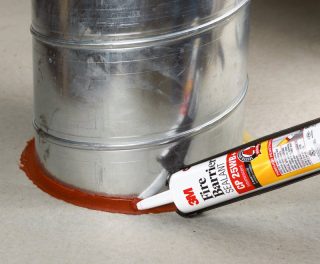
The base is cleaned from dust, oils, dried. For degreasing, take gasoline, solvent, acetone. Smooth surfaces are smoothed emery to increase adhesion. Along the edge of the connected planes glue paper tape, which is removed after joining the seam.
Operating procedure:
- the tip of the tip is trimmed at 45 ° so that a strip of the desired thickness is extruded;
- the tip is unscrewed along the thread and a hole is made in the tube so that the mass comes out, then put on again;
- the cartridge is installed in the pistol, by pressing the trigger, the paste is squeezed into the seam;
- fill the gap tightly, since the sealant does not expand during the polymerization process;
- With a spatula, shape the applied strip (within 15 minutes after application).
Recommended strip width 6 - 30 mm, depth - 2 - 12 mm. The excess mass is removed with a damp sponge or napkin. High temperature sealants are not toxic materials, but the area must be ventilated during operation.
Manufacturers rating
Popular brandsworth paying attention to:
- Hilti is of good quality and high cost. Adheres well even to smooth surfaces.
- Soudal manufactures refractory Gasket Seal and heat-resistant Fire Silicon. The second type of gray is most often used to seal the seams of fireplace masonry. Gasket Seal remains elastic after drying.
- Penosil - a professional composition for use inside heating facilities, since it can withstand a one-time temperature rise up to + 1500 ° C.
- Loktite produced on the basis of silicone and silicate, there are types for different temperatures.
- Moment. The composition works well with the external joints of heating units, ventilation and chimneys.
- Makroflex withstands + 260 ° С, one-component, resistant to weather changes, flexible. Not used for lead and copper.
- Krass used to seal joints inside the furnace space. The seam is durable with low shrinkage.
Compositions of well-known brands do not disintegrate when exposed to high temperatures, since manufacturers guarantee high quality. Universal types are more expensive, but such materials are time-tested.

